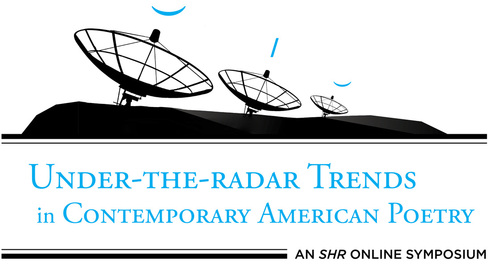|
Vertical Divider
The influence of the poetic mode that M.H. Abrams coined as the "Greater Romantic lyric" can be heard echoing through a significant number of modern poems. In poems like Robert Hass's "Meditation at Lagunitas," Elizabeth Bishop's "The End of March," and Mark Doty's "Nocturne in Black and Gold," we can find what Abrams identified as the Greater Romantic lyric's descriptive-meditative movement. A three-part structure, it starts with "description of [a] landscape" that induces "memory, thought, anticipation, [or] feeling," a process through which "the lyric speaker achieves an insight, faces up to a tragic loss, comes to a moral decision, or resolves an emotional problem" (201). The speaker's recognition urges the poem back to the instigating landscape but with a changed vision. Such an achievement, however, is often what is called, with derision, the "epiphany."
The descriptive-meditative lyric has been a suspect and contentious form for contemporary poets over the last thirty years. In particular, it has been a field for voicing skepticism over the substance and ethics of representing selfhood and knowledge. Lyn Hejinian made a charge against the mode in her influential essay "The Rejection of Closure," citing a "coercive, epiphanic mode in some contemporary lyric poetry [. . .] with its smug pretension to universality and its tendency to cast the poet as guardian to Truth" (41). In a recent essay published on the Boston Review's website, Rachel Galvin explains how we can add shame to the list of negative reactions associated with the mode. Citing Gillian White's Lyric Shame: Producing the "Lyric" Subject of Contemporary American Poetry, Galvin writes:
Yet, despite gestures toward completion—either form concluding like a snake eating its own tail or epiphany tidily placing insight in its mouth—and the meditative lyric's use of an identifiable speaker, it would be a mistake to reject the mode wholesale.
Just looking over the last fifty years, we can see fine examples of contemporary poets thinking through and against this form in order to make vital and ethical poems. This all starts with recognizing that the lyric "self" in a descriptive-meditative poem is always a provisional self, one constantly in a state of becoming, a process that involves the reader. Secondly, the more innovative versions have moved us beyond the anxiety over authenticity by accepting a poem as a made and mediating thing. Entering into the space of the descriptive-meditative lyric, the poet opens into life and life comes back. What shape the significance of that exchange takes depends upon what is at hand, as the angles and shades of landscape or cityscape become the analogs or contrasts for consciousness and understanding, or as Adrienne Rich writes in her poem "Dreamwood," "the material and the dream can join / and that is the poem" (23-24). The work of the poet, then, is never exhausted, and the poet is revealed not to be the arbiter and dispenser of absolute wisdom, but merely a person reinventing attention, who tomorrow must step in and do it again. The provisional nature of the descriptive-meditative lyric has been highlighted by contemporary versions that have replaced the instigating landscape with ekphrasis, the practice of describing other works of art in a poem. In order to begin the process of associations, a poet doesn't have to visit Tintern Abbey or Dover Beach; a poet only needs to think of a painting, or sculpture, or movie. Any visual image we can traverse and read will do. Elizabeth Bishop’s poem "Poem" would be central to this tradition. Mark Doty's "Nocturne in Black and Gold" is in it. I would even elect Ashbery's "Self-Portrait in a Convex Mirror" as a radical member of this canon. Yet, more recent poems by Jennifer Grotz, Kathleen Graber, and Mary Hickman demonstrate how vital the tradition remains. Jennifer Grotz's poem "Medusa," first published in New England Review in 2009, combines ekphrasis with the descriptive-meditative lyric, and it begins:
Grotz actually inverts the expectations for scene and evoked experience. Instead of starting in a particularized outdoor setting and associating to some image, it is the work of ekphrasis, of describing Caravaggio's "Medusa" that leads us to a determinate speaker in a landscape. The time of looking, told in the present tense, could be in the Uffizi or on Google Images. We can’t know. Yet, it is her attention to the specifics of that painting, particularly "the snakes, so many of them, / squirming in cascades as if trying to get free of / the very head they sprout from" (8-10), that provides the catalyst—and alibi—for the speaker’s memory and her direct address: "That's what you were like, a single strand / snapped free, a little shock / unburied in red clay in the last moment before winter" (12-14). Now we come to the landscape, but it is not one we control. "I didn’t know what I was looking at," the speaker explains, "what my stare awoke, / metallic blue coil that snapped like a rubber band/ and disappeared downward in the ground" (15-17). This is a snake flashing into the ground, or what must have been a snake; it was that quick. The analogy with the Medusa is what allows the speaker enough time to approach what is always in the moment of retreating:
The Medusa, then, becomes a vocabulary for the ineffable, which is what the poem seems to be after. There is a real ontological and spiritual crisis here. Through the Medusa, the speaker's spiritual impulse becomes embodied, transcendent, dangerous, and monstrous. This leads the speaker to what we might call the poem’s epiphany:
Yet, we should not over-read the force of that claim. It is provisional, operational. The sides of the equation and the means for reaching insight maintain their autonomy. Or as Grotz's poem concludes:
The snake-as-ontological-certainty is the thing itself, independent of our interpreting mind and retreating from us, and it is the thing we've internalized, a shape given substance by our witness of it, a dual feature I find common to how the descriptive-meditative lyric operates.
With Grotz's "Medusa," we can see in detail how the habit of mind in the descriptive-meditative lyric has been translated into ekphrastic poetry. Kathleen Graber has innovated on both the descriptive-meditative lyric and the ekphrastic traditions in her 2010 book The Eternal City with poems that replace conventional works of art with other forms of media, such as books and films. As Caravaggio’s "Medusa" operates in Grotz's poem, Jim Jarmusch's Dead Man acts as the instigating event, one that leads the speaker of a Graber poem, one which shares the title "Dead Man," to connect thoughts about identity and time inspired by the movie to her infant nephew. This includes the wicked thought—although perhaps no more wicked than many lullabies—of "whisper[ing] into his ear / something that feels like knowledge: / Once upon a time, there was nothing / & one day, there will be nothing again" (16-19). The eventual epiphany of Graber's poem is no less provisional and self-consciously so than in Grotz's poem. "Dead Man" arrives at the following reflection on Johnny Depp's character named William Blake: "Nobody can teach to William Blake the auguries of William Blake. / We are, instead, our own vatic visions, bumbling prophets. Our sense of ourselves / as invented as film" (43-45). The irony of this is the irony of the descriptive-meditative lyric. Perhaps the most radical and exhilarating iteration of ekphrasis blended with the descriptive-meditative lyric to have appeared in recent years comes in a group of prose poems by Mary Hickman that appeared in the Boston Review in January 2013. Hickman's "Still Life with Rayfish" uses the associative moves of the descriptive-meditative lyric to discuss paintings by Chaim Soutine, but not always to connect them directly to the speaker's life. This prose poem builds a mesh of significance, bringing in surprising comparisons to Fellini's La Dolce Vita and Adrain Lyne's psychological thriller-horror film Jacob's Ladder. The poem itself is a mesh of sources and styles, using the descriptive work of ekphrasis but with bits of biography, art history, art criticism, movie criticism, and personal reflection. The poem is a swirl of layering voices, including the lyric speaker and voices brought in through free-indirect discourse and direct quotation. Hickman has not only released the meditative lyric from the confines of landscape, but she has shown just how dynamic and expansive the scope of such lyric poetry can be. When I reread Lyn Hejinian's "The Rejection of Closure," I still sense that I am experiencing an important precursor, an adaptation in the literary genetic makeup of contemporary poetry that has allowed our poems to thrive. However, I can't help but feel like I'm reading an assessment and exhortation whose exigence has waned. Whenever I now come across a poet praising work for its subversion of lyric subjectivity, it feels dated. The descriptive-meditative lyric, especially in its ekphrastic iterations, has demonstrated again and again that lyric subjectivity always/already is subverting itself. If in no other way, the mode achieves this through its commitment to analogies, to making associative leaps between elements that are always retreating just as they arrive. PAUL OTREMBA is the author of two poetry collections, The Currency and Pax Americana. Born and raised in Minnesota, Paul studied English and Philosophy at the University of Minnesota before receiving his MFA from the University of Maryland and a PhD in literature and creative writing from the University of Houston. Paul has published widely in journals, both print and online, including The Kenyon Review, New England Review, Literary Imagination, Forklift, Witness, and multiple appearances on Poetry Daily. In honor of his poetry, he has received scholarships and a fellowship from the Bread Loaf Writers’ Conference, a Barthelme Memorial Fellowship, a Krakow Poetry Seminar Fellowship, and a prize from the Academy of American Poets. His essays, poetry reviews, and food writing have appeared in Tikkun, The Houston Chronicle, Spoon Magazine, and in the anthology American Poets in the 21st Century: The New Poetics. He has worked as a reader and editor for literary journals for many years, and he has taught poetry, literature, and composition classes at several institutions, including a culinary institute and a pre-law program. Paul is an Assistant Professor of English at Rice University.
Abrams, M. H. “Structure and Style in the Great Romantic Lyric.” Romanticism and Consciousness: Essays in Criticism. Ed. Harold Bloom. New York: Norton, 1970. 201-29.
Galvin, Rachel. “Lyric Backlash.” Boston Review. 11 February 2014. Web. 23 March 2014. Graber, Kathleen. The Eternal City. Princeton, NJ: Princeton UP, 2010. Print. Grotz, Jennifer. The Needle. New York: Houghton Mifflin Harcourt, 2011. Print. Hejinian, Lyn. “The Rejection of Closure.” The Language of Inquiry. Los Angeles: University of California Press, 2000. Print. Hickman, Mary. “Still Life with Rayfish.” Boston Review. 11 January 2013. Web. 23 March 2014. Rich, Adrienne. The Fact of a Doorframe. New York: W.W. Norton, 2002. Print. |
Paul Otremba
|
CURRENT ISSUE
|
CONTACT
|
DEPARTMENT OF ENGLISH
|



